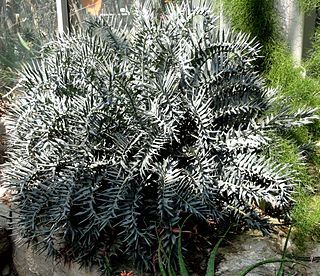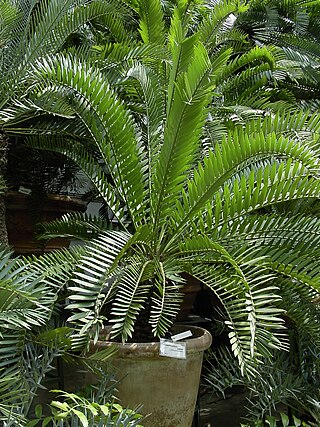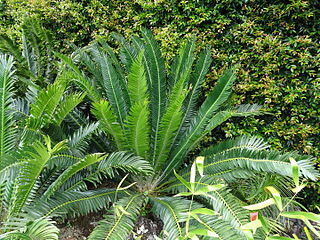
Macrozamia miquelii, is a species of cycad in the plant family Zamiaceae. It is endemic to Queensland and New South Wales in Eastern Australia. Located within sclerophyll forests dominated by eucalyptus trees, the cycad grows on nutrient-poor soils. It is recognised within the Zamiaceae family for its, medium height at 1 m, intermediate size of male and female cones and lighter green leaves compared to other cycads within the plant family of Zamiaceae. The seeds have an orange red sarcotesta which attracts fauna consumption, allowing a mutualistic seed dispersal for the cycad. These seeds are also edible for human consumption if prepared correctly to remove the toxins.

Encephalartos horridus, the Eastern Cape blue cycad, is a small, low-growing cycad up to 0.9 m (3.0 ft) high and 0.9 m (3.0 ft) wide. It is a native of Eastern Cape Province, South Africa, and found in arid shrublands, most commonly on ridges and slopes with shallow soils. The species is particularly known for its distinctly blue-gray leaves, although the degree of coloration can vary significantly. The species name horridus is Latin for 'bristly', after the plant's stiff, spiny leaflets.

Encephalartos caffer, the Eastern Cape dwarf cycad, is a rare cycad from the genus Encephalartos.

Encephalartos ghellinckii Lem. or Drakensberg cycad is endemic to South Africa, and is one of about 70 species found in sub-Saharan Africa. Strongly associated with the Natal Drakensberg, this 3m tall evergreen species is found from the foothills to fairly high altitudes, growing on stream banks, steep grassy slopes and sandstone outcrops. Its preferred habitat lying within grassveld, it has developed resistance to veldfires, and also the intense cold brought on by snow and frost.

Encephalartos senticosus is a species of cycad in the family Zamiaceae native to the Lebombo Mountains of Mozambique, Eswatini (Swaziland), and the KwaZulu-Natal province of South Africa. Prior to its description in 1996, Encephalartos senticosus had been confused with the closely related and sympatric Encephalartos lebomboensis. Both species are commonly known as the Lebombo cycad.

Encephalartos whitelockii is a species of cycad that is native to Uganda.

Encephalartos princeps is a species of cycad that is native to Eastern Cape Province of South Africa.

Encephalartos natalensis, the Natal cycad or giant cycad, is a species of cycad that is endemic to the Qumbu and Tabankulu areas of the northern part of the Eastern Cape, and through most of KwaZulu-Natal. The number of mature individuals of this species is declining and the International Union for Conservation of Nature has assessed its conservation status as being "near threatened".

Encephalartos gratus is a species of cycad that is native to Malawi and Mozambique.

Encephalartos concinnus is a species of cycad in the family Zamiaceae. It is endemic to Zimbabwe. It is known as the Runde cycad.

Encephalartos arenarius is a species of cycad in the family Zamiaceae. It is endemic to South Africa, where it is limited to the Eastern Cape. Its common names include Alexandria cycad and dune cycad.

Encephalartos hildebrandtii is a species of cycad in the Zamiaceae family. It is native to Kenya and Tanzania at elevations from sea level to 600 metres (2,000 ft). The species is named for the German explorer Johann Maria Hildebrandt.

The Chimanimani cycad is a species of cycad that is endemic to the Chimanimani Mountains of eastern Zimbabwe. It is a threatened species which has been locally extirpated by cycad collectors.
Encephalartos macrostrobilus is a species of cycad in Africa. It is found only in Moyo District, northwestern Uganda, which is populated predominantly by the ethnic Madi.

Encephalartos aemulans, the Ngotshe cycad, is a species of cycad endemic to South Africa. It is listed by the IUCN as Critically Endangered and by CITES in Appendix I. Only 100-250 are believed to be left, with a decreasing population trend. Its main threat is collecting of wild specimens.

Encephalartos aplanatus is a species of cycad in Eswatini.

Encephalartos cerinus or Waxen Cycad is a species of cycad in Africa.

Encephalartos lanatus is a species of cycad, a plant belonging to the family Zamiaceae growing in Mpumalanga, South Africa. Its specific epithet, lanatus, means wooly in Latin.

Encephalartos ngoyanus is a species of cycad in Ngoye Forest, in KwaZulu-Natal, South Africa.
Encephalartos kanga, also known as Mnanasi Pori is a species of cycad in the family Zamiaceae. It is native to Tanzania. The plant was formally described as a new species in 2007 by Tamás Pócs and Quentin Luke.






















